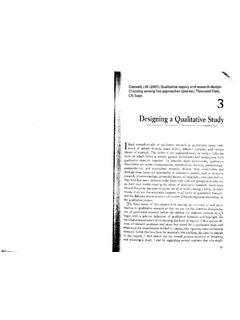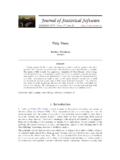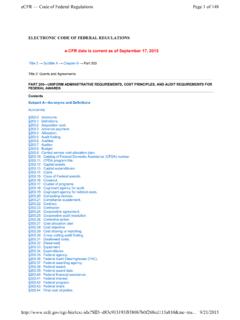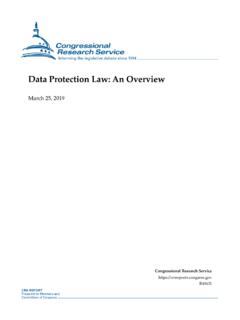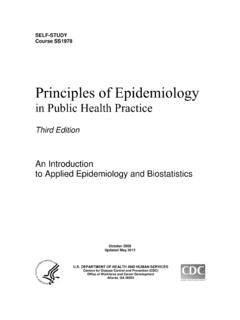Transcription of Principles of Qualitative Research: Designing a ...
1 Principles of QualitativeResearch: Designing aQualitative StudyJohn W. Creswell, L. Plano Clark, of Qualitative & Mixed Methods Research, University of Nebraska, Lincoln3 Objectives As a group activity, to plan a Qualitative study onthe topic of leadership (you may plan a study onyour topic, if you wish) To develop a PowerPoint presentation of this groupplan To cover some basic ideas about qualitativeresearch (set all of us on the same footing) usingthe Gunman Qualitative case study as an example To introduce you to the idea of traditions or types of Qualitative researchOffice of Qualitative & Mixed Methods Research, University of Nebraska, Lincoln4 What we need to know to developthis plan:!What is Qualitative research?!What types of problems are best suited forqualitative research?!How to write a Qualitative purpose statement andresearch questions!What tradition or type of Qualitative research bestfits our research problem?
2 !What types of Qualitative data we should collect?!Identifying our procedures for analyzing the data !Assessing our software packages that will helpwith data analysisOffice of Qualitative & Mixed Methods Research, University of Nebraska, Lincoln5 What is qualitativeresearch? Qualitative research is an inquiry approachin which the inquirer: explores a central phenomenon (one keyconcept) asks participants broad, general questions collects detailed views of participants in theform of words or imagesOffice of Qualitative & Mixed Methods Research, University of Nebraska, Lincoln6 What is qualitativeresearch? Qualitative research is an inquiry approach inwhich the inquirer: analyzes and codes the data for descriptionand themes interprets the meaning of the informationdrawing on personal reflections and pastresearch and writes the final report that includespersonal biases and a flexible structure. (adapted from Creswell 2002, p.)
3 58)Office of Qualitative & Mixed Methods Research, University of Nebraska, Lincoln7 What do we need to keep in mindwhen Designing a qualitativestudy? Focus on process as well as outcomes Let the design emerge Use inductive reasoning Develop a complex picture of the phenomenon(studying many ideas with few participants and sites) Discuss the context of the phenomenon Follow the scientific method ( , problem, questions, method, results)Office of Qualitative & Mixed Methods Research, University of Nebraska, Lincoln8 Starting our plan Let s provide a title for our projectOffice of Qualitative & Mixed Methods Research, University of Nebraska, Lincoln9 Start with a research topic and aresearch problem Identify the subject area or topic for thestudy Specify the research problem: The practicalissue that leads to a need for your study. Complete these sentences: The topic for this study will This study needs to be Office of Qualitative & Mixed Methods Research, University of Nebraska, Lincoln10 Let s write down the topic and theresearch problem leading to our studyOffice of Qualitative & Mixed Methods Research, University of Nebraska, Lincoln11 Now we will write a goodqualitative purpose statement: What it includes: Single sentence The purpose of this study.
4 Central phenomenon Qualitative words ( explore, understand, discover ) Participants Research siteOffice of Qualitative & Mixed Methods Research, University of Nebraska, Lincoln12 Understanding the centralphenomenon: Quantitative research Qualitative researchXYIndependentVariable influencesDependentVariableYCentral PhenomenonOffice of Qualitative & Mixed Methods Research, University of Nebraska, Lincoln13 Let s stay away fromquantitative language thatmight mislead readers What is not included in this statement: Not a comparison Not relating variables Not proving hypotheses Not measuring variablesOffice of Qualitative & Mixed Methods Research, University of Nebraska, Lincoln14 Here is a script for a goodqualitative purpose statement: The purpose of this Qualitative study (replace laterwith type of Qualitative tradition) will be to_____(understand, describe, develop, discover)the _____(central focus) for_____(participants: person, process, groups) at_____(site).
5 "Office of Qualitative & Mixed Methods Research, University of Nebraska, Lincoln15 Writing good Qualitative researchquestions Questions narrow the purpose Two types: Central question The most general question you could ask Sub questions Sub-divides central question into morespecific topics questions Limited numberOffice of Qualitative & Mixed Methods Research, University of Nebraska, Lincoln16 Use good Qualitative wording forthese questions Begin with words such as how, what, Tell the reader what you are attempting to discover, generate, explore, identify, or describe Ask what happened? to describe Ask What was the meaning to people of whathappened? to understand Ask What happened over time? to explore aprocessOffice of Qualitative & Mixed Methods Research, University of Nebraska, Lincoln17 Avoid words such as: relate influence impact effect cause Office of Qualitative & Mixed Methods Research, University of Nebraska, Lincoln18 Scripts to help design qualitativecentral questions and sub-questions:Central Question Script: (usually write only one) What does it mean to _____ (centralphenomenon)?
6 How would _____ (participants) describe_____ (central phenomenon)?"Sub-Question Script: (What) _____ (aspect) does _____(participant) engage in as a _____(centralphenomenon)? Office of Qualitative & Mixed Methods Research, University of Nebraska, Lincoln19 Write the purpose statement, centralquestion, and sub-questions for ourqualitative studyOffice of Qualitative & Mixed Methods Research, University of Nebraska, Lincoln20 Let s design the methods for thisqualitative study. What to include: data collection data analysis data representation data interpretation data validation The type of Qualitative tradition we will use inour methodsOffice of Qualitative & Mixed Methods Research, University of Nebraska, Lincoln21 What are the qualitativetraditions? Narrative research Phenomenology Ethnography Grounded Theory Case Study In-depth study of a case or cases Description of the cultural behavior of a group or an individual Theory or theoretical model Description of the essence of the experience Detailed picture of an individual s lifeNarrativeForm Description Themes Assertions Description Analysis Interpretation Open coding Axial Coding Selective Coding Conditional Matrix Statements Meanings Meaning themes General description of the experience Stories Epiphanies Historical contentDataAnalysis Multiple sources including documents, archival records, interviews, observations, Physical artifacts Primarily observations and interviews with additional artifacts during extended time in the field ( 6 months to a year)
7 Interviews with 20-30 individuals to saturate categories and detail a theory Long interviews with up to 10 people Primary interviews and documentsDataCollection Developing an in-depth analysis of a single case or multiple cases Describing and interpreting a cultural or social group Developing a theory grounded from data in the field Understanding the essence of experiences about a phenomenon Exploring the life of an individualFocusCase StudyEthnographyGroundedTheoryPhenomenol ogyNarrativeDimensionThe Qualitative TraditionsOffice of Qualitative & Mixed Methods Research, University of Nebraska, Lincoln23 What criteria will we use to selecta tradition? Intent or focus Audience Personal training/skills Personal comfort level with structureOffice of Qualitative & Mixed Methods Research, University of Nebraska, Lincoln24 Now, let s select a tradition for ourstudy Choose a Qualitative tradition for ourresearch problem.
8 Tell why we chose it and how it relates tothe study s of Qualitative & Mixed Methods Research, University of Nebraska, Lincoln25 Within this tradition, what data willwe collect? Who will be studied? What information will be collected?Office of Qualitative & Mixed Methods Research, University of Nebraska, Lincoln26 Four considerations for selectingpeople/sites to study: Can the people and sites help us learn aboutour central phenomenon? (purposefully selectpeople and sites) How many people and sites should we study?(keep sample size small) Do we have access? (gain access) Do we have permissions (obtain permissions)Office of Qualitative & Mixed Methods Research, University of Nebraska, Lincoln27 What types of information can becollected in Qualitative research? Observations Interviews Documents Audio-Visual MaterialsOffice of Qualitative & Mixed Methods Research, University of Nebraska, Lincoln28If we choose to observe, how dowe do it?
9 Create an observational protocol Record descriptive notes Record reflective notes Decide on your observational stance Enter site slowly Conduct multiple observations Summarize at end of each observationOffice of Qualitative & Mixed Methods Research, University of Nebraska, Lincoln29If we choose to interview, how dowe interview? Decide on the type of interview to use Individual Focus group Telephone e-mail Create an interview protocol Ask open-ended questions (5-7) allows the participant to create options forresponding participants can voice their experiences andperspectives If possible, tape record and transcribe for analysisOffice of Qualitative & Mixed Methods Research, University of Nebraska, Lincoln30 Let s write down in our plan our datacollection approach1)Sites to be studied2)People to be studied3)Permissions needed4)Types of data to be collected5)Forms needed for data collectionOffice of Qualitative & Mixed Methods Research, University of Nebraska, Lincoln31 Once we collect the data , how will weanalyze it?
10 The overall processCodes the Text forDescription to be Usedin the Research ReportCodes the Text forThemes to be Usedin the Research ReportThe Researcher Codes the data ( , locates text segments and assigns a code to label them)The Researcher Prepares data for analysis( , transcribes fieldnotes)The Researcher Collects data ( , a text file, such as fieldnotes, transcriptions, optically scanned material)The Researcher Reads Through data ( , obtains general sense of material)SimultaneousInteractiveOffice of Qualitative & Mixed Methods Research, University of Nebraska, Lincoln32 More specific steps in the analysisprocess Exploring the database Coding the data Developing findings - a description and themes (Re) presenting the description and themes Interpreting the findings Validating the findingsOffice of Qualitative & Mixed Methods Research, University of Nebraska, Lincoln33 How do we first explore thedatabase?
